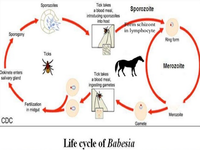








Babesia is a genus of protozoan apicomplexan piroplasms which was discovered by the Romanian bacteriologist Victor Babe?, that infect the blood and cause a parasitic, hemolytic disease known as babesiosis. Over 100 species of Babesia have been identified, but only a few have been documented to be pathogenic in humans.
Early History
For centuries, babesiosis was known to be a serious illness for wild and domesticated animals, especially cattle. Victor Babe?, who first documented the disease in Romania in 1888, described symptoms of a severe hemolytic illness seen uniquely in cattle and sheep.Although he identified the causative agent in 1888, he incorrectly believed it to be due to the bacterium he named Haematococcus bovis.
In 1893, Americans Theobald Smith and Fred Kilborne identified the parasite as the cause of Texas cattle fever, the same disease described by Babes. Smith and Kilborne also identified the tick as the agent of transmission, a discovery that first introduced the concept of arthropods functioning as disease vectors.Long believed to be a disease that only affected nonhuman mammals, the first case of babesiosis was seen in humans in 1957.The first case was observed in a splenectomized patient (as were all people diagnosed with the infection until 1969). The first case of babesiosis seen in a nonsplenectomized patient proved the protozoan parasite was a potential pathogen in anyone.